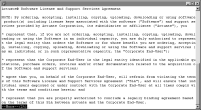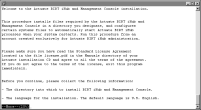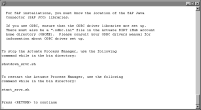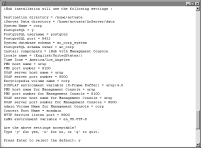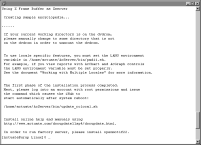How to perform a new installation of BIRT iHub in Linux
To reduce network traffic, you can install BIRT iHub on the same host machine as the iHub system database. You can also install BIRT iHub and the metadata database on a different machine to distribute processing across multiple machines.
Actuate recommends running the installation procedure from an account created exclusively for iHub administration. To install iHub, perform the following steps:
1 Download the required files from the FTP software distribution site. Extract the files.
2 To install the server files, execute the isinstall script:
sh ./isinstall.sh
The script displays a series of prompts. Respond to the prompts as described in the following procedures.
3 The license agreement appears, as shown in
Figure 2‑1.
4 Read the license agreement, then press Enter to continue the installation. At the prompt, type y for yes if you accept the licensing terms, as shown in
Figure 2‑2.
5 The introduction to the installation appears, as shown in
Figure 2‑3.
Figure 2‑1 Reviewing the license agreement
Figure 2‑2 Accepting the licensing terms
Figure 2‑3 Reviewing the introductory information
6 Press Return or Enter after finishing the review of the introductory information, as shown in
Figure 2‑4.
Figure 2‑4 Finishing the review of introductory information
7 Press Enter to accept the default installation directory for BIRT iHub binaries, as shown in
Figure 2‑5. If installing BIRT iHub side-by-side with a Release 11 version of BIRT iServer to migrate from a Release 11 iServer to iHub, type a different directory, such as /home/actuate/iHub and press Enter. Alternatively, type a different directory and press Enter.
The installation program creates the Actuate directory in the chosen location. iHub uses this location to resolve the path to all binaries that it launches.
The default path is /home/actuate. If installing BIRT iHub side-by-side with a Release 11 version of BIRT iServer, the default path is /home/actuate/iHub. This documentation uses the environment variable AC_SERVER_HOME to refer to $HOME/AcServer in case the installer chooses a path that is different from the default path.
Figure 2‑5 Specifying the installation directory
8 Press Enter to accept the default installation directory, AC_SERVER_HOME/data, for iHub data, as shown in
Figure 2‑6. Alternatively, choose a different directory for iHub data.
iHub uses this data location to store the iHub Encyclopedia volume data, including PostgreSQL metadata, logs, and other files.
Figure 2‑6 Specifying the data installation directory
9 Press Enter to accept the default option of creating the directory for data, as shown in
Figure 2‑7. Alternatively, type n for no, or q to quit, and press Enter.
Figure 2‑7 Creating the AC_DATA_HOME directory
10 The installer copies prerequisite files to the destination folder, as shown in
Figure 2‑8. After the prerequisite files are copied, the installation continues.
Figure 2‑8 Copying prerequisite files
11 Press Enter to accept the default iHub component combination, which includes Management Console, as shown in
Figure 2‑9. Alternatively, choose a different component combination and press Enter.
Figure 2‑9 Choosing the components to install
Figure 2‑10 Specifying the type of iHub to install
13 Type a name to use for the BIRT iHub System name, as shown in
Figure 2‑11. iHub assigns this name to the default Encyclopedia volume. Additionally, iHub inserts this name into the names iHub creates for the Encyclopedia volume schema and the iHub system schema.
Figure 2‑11 Specifying the BIRT iHub System name
14 Press Enter to choose the default embedded PostgreSQL database to store the Encyclopedia volume metadata, as shown in
Figure 2‑12.
Figure 2‑12 Choosing the embedded PostgreSQL
15 Press Enter to choose the default PostgreSQL superuser name, postgres, as shown in
Figure 2‑13. Alternatively, type a different PostgreSQL superuser name. This superuser administers the PostgreSQL relational database management system (RDBMS).
Figure 2‑13 Choosing the PostgreSQL superuser name
16 Type a PostgreSQL superuser password that conforms to the password security policy requirements within your organization, then press Enter, as shown in
Figure 2‑14.
Figure 2‑14 Typing the PostgreSQL superuser password
17 Re-enter the password for PostgreSQL superuser, then press Enter, as shown in
Figure 2‑15.
Figure 2‑15 Re-entering the PostgreSQL superuser password
18 Press Enter to accept the default port on which PostgreSQL listens for requests, as shown in
Figure 2‑16.
If the install program detects that the default port number is in use, the install program displays the next highest port number available For example, if the default port is 8432, but another process is using that port, the install program displays the next available port, such as 8433.
Figure 2‑16 Choosing the PostgreSQL port number
19 Press Enter to select the default locale, which is English, as shown in
Figure 2‑17. Alternatively, select a different locale. If you do not see the locale for your region, type m for more and press Enter.
Figure 2‑17 Specifying a locale
20 Press Enter to select the default time zone, which is America/Los_Angeles, as shown in
Figure 2‑18. Alternatively, select another time zone from the numbered list.
Figure 2‑18 Specifying a time zone
21 To evaluate the product using the included evaluation software license press Enter, as shown in
Figure 2‑19. Alternatively, type 2, then type the path to a purchased license file.
Figure 2‑19 Specifying license type
22 Press Enter to accept the hostname of the machine that Management Console uses to contact the Process Management Daemon (PMD), as shown in
Figure 2‑20. Alternatively, type a different IP address.
Figure 2‑20 Specifying the hostname that Management Console uses to contact the PMD
23 Press Enter to accept the default port number, 8100, where Process Management Daemon (PMD) listens for requests, as shown in
Figure 2‑21. Alternatively, type a different port number and press Enter.
Figure 2‑21 Specifying the port number on which the PMD listens
24 Press Enter to accept the default host name, the name of the machine on which iHub runs, as shown in
Figure 2‑22. Alternatively, type a different host name or IP address, then press Enter.
Figure 2‑22 Specifying the machine on which the iHub runs
25 Press Enter to accept the default port number where iHub listens to requests, as shown in
Figure 2‑23. Alternatively, type a different port number and press Enter.
Figure 2‑23 Specifying the port number on which the iHub listens
26 Specify the iHub administrator password, as shown in
Figure 2‑24. You use this password to log into the iHub Configuration Console.
Figure 2‑24 Specifying the iHub administrator password
27 Re-enter the password of the iHub administrator, as shown in
Figure 2‑25. You use this password to log in to Configuration Console.
Figure 2‑25 Re-entering the iHub administrator password
28 Press Enter to accept the default option to use a volume name for the Encyclopedia, as shown in
Figure 2‑26. Alternatively, type n for no to not use a volume name for the Encyclopedia, or q to quit the installation.
Figure 2‑26 Specifying whether to use an Encyclopedia volume name
29 Press Enter to accept the default Encyclopedia volume name, the BIRT iHub System name, as shown in
Figure 2‑27. Alternatively, type a different Encyclopedia volume name.
Figure 2‑27 Specifying the Encyclopedia volume name
30 Press Enter to accept the default option to start iHub automatically, as shown in
Figure 2‑28. Alternatively, type n for no.
Figure 2‑28 Specifying whether to start iHub automatically
31 Press Enter to accept the default option to not integrate LDAP with iHub, as shown in
Figure 2‑29. Alternatively, you can edit the setting.
Figure 2‑29 Specifying whether to integrate LDAP with iHub
32 Press Enter to accept the default option to not use any database drivers/clients, as shown in
Figure 2‑30. Alternatively, type y for yes, and specify the database drivers/clients you want to use.
Figure 2‑30 Specifying whether to use database drivers/clients
33 Specify what kind of X-Server you want to use, if any. To accept the default, press Enter, as shown in
Figure 2‑31.
34 Press Enter to accept the hostname of the machine that Management Console uses to contact the Process Management Daemon (PMD), as shown in
Figure 2‑32. Alternatively, type a different IP address.
35 Press Enter to accept the default port number, 8100, on which the Process Management Daemon (PMD) listens for requests from Management Console, as shown in
Figure 2‑33. Alternatively, type a different port number.
Figure 2‑31 Specifying what kind of X-Server to use, if any
Figure 2‑32 Specifying the hostname that Management Console uses to contact the PMD
Figure 2‑33 Specifying the port number for the PMD to listen for requests from Management Console
36 Press Enter to accept the hostname or enter the IP address of the machine that Management Console uses to contact iHub, as shown in
Figure 2‑34. Alternatively, type a different IP address.
Figure 2‑34 Specifying the hostname that Management Console uses to contact iHub
37 Press Enter to accept the default port number, 8000, on which iHub listens for requests from Management Console, as shown in
Figure 2‑35. Alternatively, type a different port number.
Figure 2‑35 Specifying the port number on which iHub listens for requests from Management Console
38 Press Enter to accept the name of the default Encyclopedia volume to use with Management Console, as shown in
Figure 2‑36. Alternatively, type a different name for the Encyclopedia volume.
Figure 2‑36 Specifying the name of the default Encyclopedia volume
39 Press Enter to accept the default name, acadmin, for the HTTP server context root for Management Console configuration, as shown in
Figure 2‑37. Alternatively, type a different name.
Figure 2‑37 Specifying the name of the HTTP server context root
40 Press Enter to accept the default HTTP port number, 8900, on which the application container listens to requests, as shown in
Figure 2‑38. Alternatively, choose a different port.
You connect to the port from your browser when accessing various features of iHub.
Figure 2‑38 Specifying the application container listening port number
41 Review the settings, as shown in
Figure 2‑39, then specify whether you accept the settings. Press Enter to accept the default, y for yes. Alternatively, type n for no, or q to quit.
Figure 2‑39 Reviewing the installation settings
42 The installation program installs iHub, displaying an indicator that shows the progress of the installation, as shown in
Figure 2‑40.
Figure 2‑40 Viewing iHub installation progress
43 At the end of the installation, the program asks if you want to start iHub. Accept the default, y for yes, to start iHub, as shown in
Figure 2‑41.
Figure 2‑41 Specifying whether to start iHub
44 When the installation program finishes, it provides additional information about localization, logging in using an account with root permissions to start iHub, and installing online help and manuals, as shown in
Figure 2‑42.
Figure 2‑42 Viewing information about localization, logging in, and installing online help
